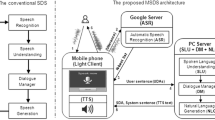Abstract
We present a dialogue system that enables the access in natural language to a web law information retrieval system. We use a semantic web language to model the document knowledge and to define an ontology representing the main classes of domain objects, their properties and their relations. Our system includes an ontology in DAML+OIL language describing the documents structure, a document database build with a subset of the Portuguese Attorney General’s Office documents were each document includes a field with its semantic content described in DAML+OIL. The dialogue system interprets the user natural language sentences using the ontology, the documents semantic content and the inferred user attitudes.
Preview
Unable to display preview. Download preview PDF.
Similar content being viewed by others
References
D. Brickley and R. Guha. Resource Description Framework (RDF) — Schema Specification. W3C, 1999.
Gerald Gazdar and Chris Mellish. Natural Language Processing in PROLOG. Addison-Wesley, 1989.
Jerry Hobbs, Mark Stickel, Douglas Appelt, and Paul Martin. Interpretation as abduction. Technical Report SRI Technical Note 499, 333 Ravenswood Ave., Menlo Park, CA 94025, 1990.
H. Kamp and U. Reyle. From Discourse to Logic. Kluwer, Dordrecht, 1993.
O. Lassila and R. Swick. Resource Description Framework (RDF) — Model and Syntax Specification. W3C, 1999.
P. Quaresma and J. G. Lopes. Unified logic programming approach to the abduction of plans and intentions in information-seeking dialogues. Journal of Logic Programming, 54, 1995.
Paulo Quaresma and Irene Rodrigues. Using logic programming to model multi-agent web legal systems — an application report. In Proceedings of the ICAIL’01 — International Conference on Artificial Intelligence and Law, St. Louis, USA, May 2001. ACM. 10 pages.
Luis Quintano, Irene Rodrigues, and Salvador Abreu. Relational information retrieval through natural lanaguage analysis. In Proceedings of INAP’01, Tokyo, Japan, October 2001. INAP.
http://www.daml.org. DAML+OIL — DARPA Agent Markup Language, 2000.
Author information
Authors and Affiliations
Editor information
Editors and Affiliations
Rights and permissions
Copyright information
© 2003 Springer-Verlag Berlin Heidelberg
About this paper
Cite this paper
Quaresma, P., Rodrigues, I. (2003). Using Dialogues to Access Semantic Knowledge in a Web IR System. In: Mamede, N.J., Trancoso, I., Baptista, J., das Graças Volpe Nunes, M. (eds) Computational Processing of the Portuguese Language. PROPOR 2003. Lecture Notes in Computer Science(), vol 2721. Springer, Berlin, Heidelberg. https://doi.org/10.1007/3-540-45011-4_32
Download citation
DOI: https://doi.org/10.1007/3-540-45011-4_32
Published:
Publisher Name: Springer, Berlin, Heidelberg
Print ISBN: 978-3-540-40436-1
Online ISBN: 978-3-540-45011-5
eBook Packages: Springer Book Archive




